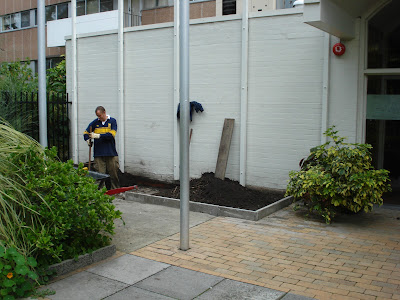The two trees as they once stood (spot the arborist)
Looks bare now doesn't it?
No more sign. I hope people can still find the general office and the meeting rooms.
Digging around the services pit to install more edging.
But boss its all roots in there!
Here's me digging away. Notice the posts on the wall with steel cable run horizontally every foot or so.
That looks better. All the edging is done and compost has been dug through now time to plant some annuals.
Annuals are now all in place. We planted stocks, violas, pansies, primulas and also some ornamental mizuna (Japanese mustard). There are also some tulip bulbs in there
The bed as it is now.
We tried to plant the annuals with the smalls in the front and talls at the back. Damn it we didn't count on the mizuna being so tall, live and learn i suppose. The stocks and some of the others in there still haven't bloomed or reached their full height as it's still only early spring. A wise gardener once told me that gardening is a process not an end result and we aren't finished with this bed. I'll try to post more pics after the annuals are replaced and the creeper is established the back wall.

































